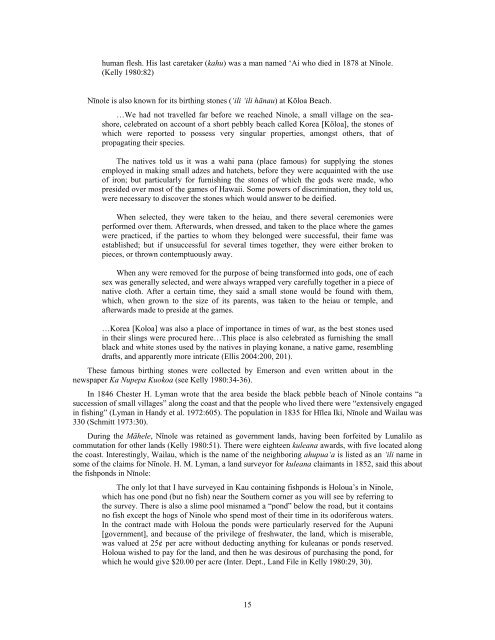Honu'apo Park Resource Management Plan
Honu'apo Park Resource Management Plan
Honu'apo Park Resource Management Plan
You also want an ePaper? Increase the reach of your titles
YUMPU automatically turns print PDFs into web optimized ePapers that Google loves.
human flesh. His last caretaker (kahu) was a man named ‘Ai who died in 1878 at Nīnole.<br />
(Kelly 1980:82)<br />
Nīnole is also known for its birthing stones (‘ili ‘ili hānau) at Kōloa Beach.<br />
…We had not travelled far before we reached Ninole, a small village on the seashore,<br />
celebrated on account of a short pebbly beach called Korea [Kōloa], the stones of<br />
which were reported to possess very singular properties, amongst others, that of<br />
propagating their species.<br />
The natives told us it was a wahi pana (place famous) for supplying the stones<br />
employed in making small adzes and hatchets, before they were acquainted with the use<br />
of iron; but particularly for furnishing the stones of which the gods were made, who<br />
presided over most of the games of Hawaii. Some powers of discrimination, they told us,<br />
were necessary to discover the stones which would answer to be deified.<br />
When selected, they were taken to the heiau, and there several ceremonies were<br />
performed over them. Afterwards, when dressed, and taken to the place where the games<br />
were practiced, if the parties to whom they belonged were successful, their fame was<br />
established; but if unsuccessful for several times together, they were either broken to<br />
pieces, or thrown contemptuously away.<br />
When any were removed for the purpose of being transformed into gods, one of each<br />
sex was generally selected, and were always wrapped very carefully together in a piece of<br />
native cloth. After a certain time, they said a small stone would be found with them,<br />
which, when grown to the size of its parents, was taken to the heiau or temple, and<br />
afterwards made to preside at the games.<br />
…Korea [Koloa] was also a place of importance in times of war, as the best stones used<br />
in their slings were procured here…This place is also celebrated as furnishing the small<br />
black and white stones used by the natives in playing konane, a native game, resembling<br />
drafts, and apparently more intricate (Ellis 2004:200, 201).<br />
These famous birthing stones were collected by Emerson and even written about in the<br />
newspaper Ka Nupepa Kuokoa (see Kelly 1980:34-36).<br />
In 1846 Chester H. Lyman wrote that the area beside the black pebble beach of Nīnole contains “a<br />
succession of small villages” along the coast and that the people who lived there were “extensively engaged<br />
in fishing” (Lyman in Handy et al. 1972:605). The population in 1835 for Hīlea Iki, Nīnole and Wailau was<br />
330 (Schmitt 1973:30).<br />
During the Māhele, Nīnole was retained as government lands, having been forfeited by Lunalilo as<br />
commutation for other lands (Kelly 1980:51). There were eighteen kuleana awards, with five located along<br />
the coast. Interestingly, Wailau, which is the name of the neighboring ahupua‘a is listed as an ‘ili name in<br />
some of the claims for Nīnole. H. M. Lyman, a land surveyor for kuleana claimants in 1852, said this about<br />
the fishponds in Nīnole:<br />
The only lot that I have surveyed in Kau containing fishponds is Holoua’s in Ninole,<br />
which has one pond (but no fish) near the Southern corner as you will see by referring to<br />
the survey. There is also a slime pool misnamed a “pond” below the road, but it contains<br />
no fish except the hogs of Ninole who spend most of their time in its odoriferous waters.<br />
In the contract made with Holoua the ponds were particularly reserved for the Aupuni<br />
[government], and because of the privilege of freshwater, the land, which is miserable,<br />
was valued at 25¢ per acre without deducting anything for kuleanas or ponds reserved.<br />
Holoua wished to pay for the land, and then he was desirous of purchasing the pond, for<br />
which he would give $20.00 per acre (Inter. Dept., Land File in Kelly 1980:29, 30).<br />
15


